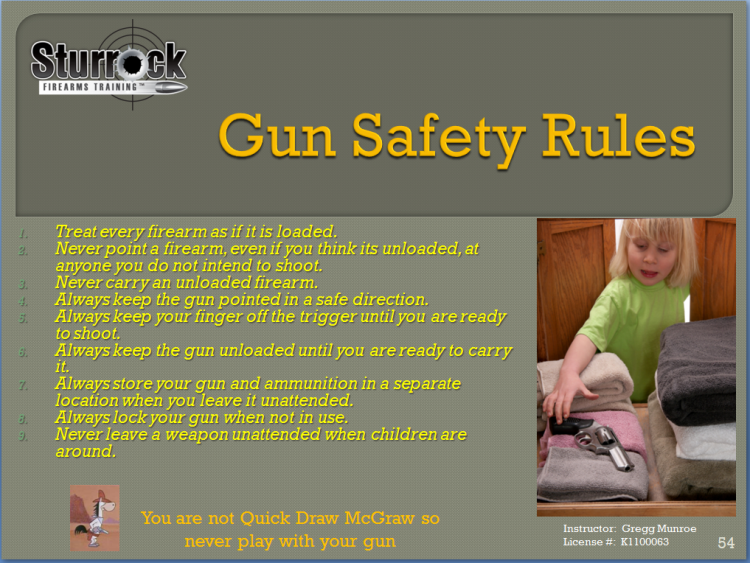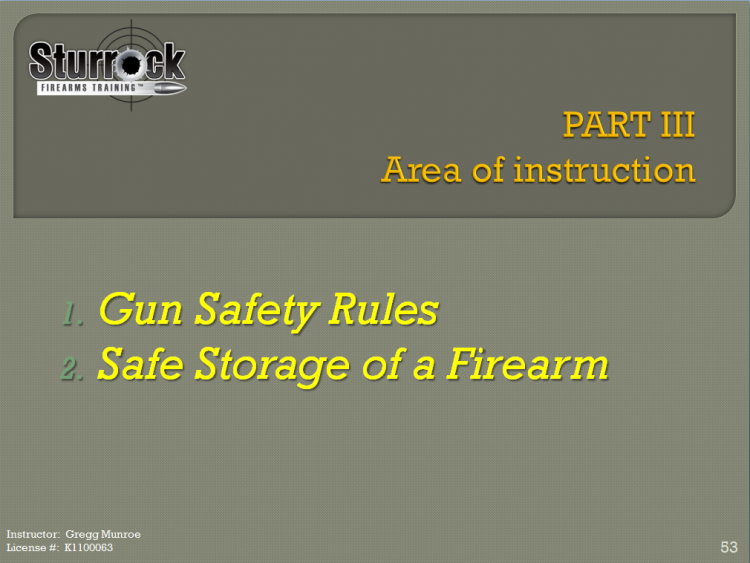PART IV Class Instruction
During this block of instruction we will discuss basic gun safety rules, safe storage of a firearm and basic handgun safety handling.
If you follow these very simple, yet important safety rules, you'll never have an accident. You must also take these safety rules very serious as any missteps can cause the firearm to fire unexpectedly.
STEPS:
1) Treat every firearm as if it is loaded.
a) Never presume the firearm is unloaded and before handling the firearm inspect it to confirm that it is either loaded or unloaded.
2) Never point a firearm, even if you just unloaded it, at anyone you do not intend to shoot.
3) Never carry an unloaded firearm.
a) If you attempt to carry an unloaded firearm on you then the gun is useless and can only get yourself hurt or killed. And, when I say unloaded, I also include those of you with a semi-automatic firearm
PART IV
ESTIMATED COMPLETION TIME:
15 MINUTES
that only place a loaded magazine in the gun but do not load a round in the chamber. In most instances when you need to pull your firearm you won't have time to chamber a round or put a magazine in the gun itself. When you need to use the gun your best bet is to have it fully loaded and ready to fire. That's what gun safeties are for. I recommend any new gun owner or anyone who is not familiar with a firearm to buy a firearm with at least one safety. This has many benefits.
4) Always keep your firearm pointed in a safe direction.
a) This way if you have an accidental discharge you will not shoot anyone accidentally.
b) What does "safe direction" mean. It means away from any individual and usually pointing your firearm towards the ground.
5) Always keep your finger off the trigger until you are ready to shoot.
a) You might ask why or you might say it will take too long to fire a shot.
b) The why is that you will be less likely to accidentally discharge your firearm if you leave your finger out of the trigger until you have your firearm pointed at your intended target.
c) And no, it won't take anymore time as you should be trained to begin to move your finger onto the trigger as you are raising your firearm. Once you have your gun pointed at its intended target your finger can move in there safely and quickly to fire if needed.
6) Always keep your gun unloaded until you are ready to carry it or use it for home protection.
a) This might seem counter to #3, but it's not. What I mean by this is never leave an unattended gun loaded. For example, if you are going to leave your gun at home when you leave, then do one of the following, unload it and/or lock it in a safe or other type of storage container. The reason for this is in the unlikely event that an intruder burglarizes your home he will not find a fully loaded and operational firearm. There have been times when stolen guns have been used to commit other crimes and more tragically, have been used on the owner when they have come home and interrupted a burglary in progress. So, don't leave a loaded gun accessible to anyone.
7) Always store your gun and ammunition in a separate location.
a) This also applies to #5. Never give anyone access to both your gun and ammunition.
8) Always lock your gun when not in use.
a) There are times when your firearm is never unloaded because you use it for home protection and take it with you either in your car or carry it on your person when you leave the house. As long as the firearm is either in your control or strategically placed in your home for home protection, then it can remain loaded. However, when you leave the gun unattended then you need to lock it up and follow directions for #5 and #6.
9) Never leave your weapon unattended when children are around.
a) If they get a hold of your loaded weapon they can harm themselves or others.
b) It is also not a good idea to simply have a safety talk with your children and tell them how dangerous it is to play with a gun and even go as far as forbidding them to touch your guns when you are not around. Trust me, that talk is not always going to have the impact you think it does. They will understand what you're saying, but their minds are not developed enough to stop them from their urge or desires or curiosity to play with a firearm. They probably will not remember all of the safety training you gave them.
10) Get instruction on how to use your gun before you handle it.
a) Before handling a gun, learn how it operates. Know its basic parts, how to safely open and close the action and remove any ammunition from the gun or magazine. Remember, a gun's mechanical safety device is never foolproof. Nothing can ever replace safe gun handling.
11) Be sure the gun is safe to operate.
a) Just like other tools, guns need regular maintenance to remain operable. Regular cleaning and proper storage are a part of the gun's general upkeep. If there is any question concerning a gun's ability to function, a knowledgeable gunsmith should look at it.
12) Use the correct ammunition for your particular firearm or caliber firearm.
a) Most guns have the ammunition type stamped on the barrel. Ammunition can be identified by information printed on the box and sometimes stamped on the cartridge. Do not shoot the gun unless you know you have the proper ammunition.
13) Never use alcohol or over the counter medication/prescriptions before handling a firearm.
a) Alcohol, as well as any other substance likely to impair normal mental or physical bodily functions, must not be used before or while handling or shooting guns.
14) When appropriate, wear ear and eye protection before firing your firearm.
a) This is geared to those people using either an indoor or outdoor firing range. It obviously will not be practice if you are using your firearm to protect yourself or another. But, guns are loud and the noise can cause hearing damage. They can also emit debris (flying hot brass from a semi-automatic pistol) and hot gas that could cause eye injury. For these reasons, shooting glasses and hearing protectors should be worn by shooters and spectators.
To reiterate the gun safety rules above, it is important for you to safely store/lock up your firearm when it's not being used. In the adjacent slide you see four different ways to lock up your firearm so it cannot be used against you or stolen from you. As stated above, use one of these methods or any other method that will lock and render your firearm safe to store your firearm when it's not being used. The first picture is a trigger lock guard. This goes over and around your trigger. If you cannot pull the trigger then you cannot fire the gun. The second picture is a hard-sided gun case. Place an unloaded gun in the case and use a lock of some sort to secure it. DO NOT also put your ammo in there or loaded magazines if you have a semi-automatic firearm. Now, I know many of you won't do that as it's inconvenient, but it might save yours or someone else's life one day. The third way is to place your firearm in a locked safe. They make safes nowadays with bio-metric entry locks which makes it very easy and quick to get access to your firearm. I have no problem with you leaving a fully
loaded firearm in a safe as this is probably the safest and most secure way to safeguard your firearm. Fourth, we have the gun cable lock. It's like a bicycle lock. It's a metal rope or chain with a padlock at the end. For revolvers you open up the cylinder and place the lock through there and for a semi-automatic firearm you take out the magazine and lock the slide to the rear and place the cable down the opening in the gun grip. Each of these methods will suffice to lock up and make your gun safe. Lastly, we talked above about making your gun accessible to minors. The state of Florida states if you leave a loaded firearm on your premise knowing a minor under 16 might have access to it, you have committed a misdemeanor of the 2nd degree.
NRA Instructor: Gregg Munroe
License #: 210405662
NRA Instructor: Gregg Munroe
License #: 210405662
NRA Instructor: Gregg Munroe
License #: 210405662
NRA Instructor: Gregg Munroe
License #: 210405662






